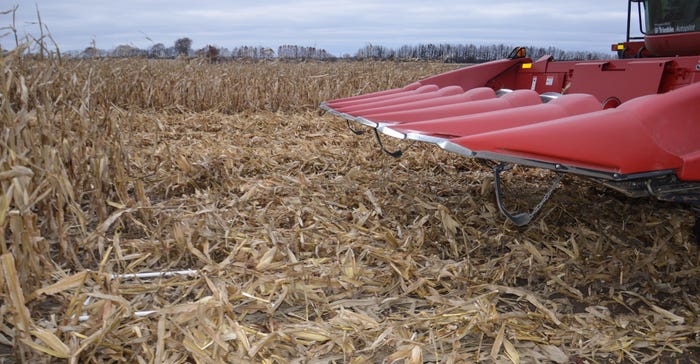
The first step to knowing if you’re doing a good job adjusting your combine while harvesting is to measure losses. If you don’t take time to measure and minimize losses as you go, and it’s a warm, moist fall, corn or soybeans you leave behind may sprout and show just how good or poor a job you did!
That’s not the time to find out, notes Bob Nielsen, Purdue University Extension corn specialist. He recommends taking time to measure losses when you can still do something about it — during harvest.
Nielsen supervised a trial at the Throckmorton Purdue Agricultural Center in 2019 that compared harvesting corn at three different times. The trial was sponsored by Indiana Prairie Farmer. Seed was supplied by Beck’s. Pete Illingworth and the Throckmorton farm crew planted and harvested the crop.
You can construct a wooden frame or mark an area with wooden stakes to measure kernels or beans left behind by the combine, Nielsen says. For the 2019 corn trial, an easy-to-transport, lightweight frame of PVC pipe was constructed.
The key is for the inside diameter to be 10 square feet, Nielsen says. Two kernels of corn per square foot equal 1 bushel of corn. So, 20 kernels per 10-square-foot frame equal 1 bushel of corn. For soybeans, four beans per square foot equal 1 bushel.
Here are the steps for building a frame with PVC pipe:
1. Secure the supplies. A University of Georgia Extension bulletin notes that a frame 30 inches wide and 48 inches long equals 10 square feet — that’s the inside diameter of the frame.
Buy enough length of 1-inch-diameter PVC pipe to form the frame, plus four elbows to fit on the corners.
2. Cut the correct lengths. A hacksaw makes quick work of PVC pipe if it is secured firmly within a vise on a workbench. Cut two lengths of 48 inches for the longer sides and two of 30 inches for the shorter sides.
3. Lay out the pipe and measure. Find a level spot to lay out the frame before assembling it. Check the inside diameter both up and down and across to make sure measurements are correct.
4. Attach the four elbows. They need to fit snugly. If you want to make sure they don’t come apart, apply an adhesive. Before you do, it’s worth one final check to make sure that after the elbows are in place, the inside dimensions are still 30 inches by 48 inches.
Check out the slideshow to see photos of this process.
About the Author(s)
You May Also Like




